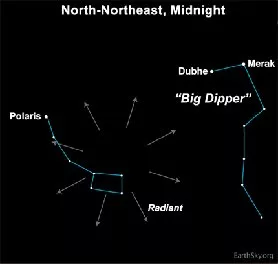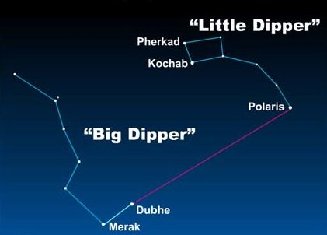View Other Topics.
 Dec 21, 2016
Dec 21, 2016
EarthSky.org says the annual Ursid meteor shower always peaks near the time of the December winter solstice, so, in 2016, look for some possible activity over the next several nights. The forecast calls for December 21-22 to be the peak night. Normally a sparse shower, you might see about five meteors per hour. This shower favors the more northerly latitudes in the Northern Hemisphere.
All meteors in annual showers have radiant points on our sky’s dome, and the showers take their names from the constellations in which the radiant points lie. The Little Dipper asterism is in the constellation Ursa Minor the Lesser Bear. Hence, the Ursid meteor shower. If you trace the paths of the rather slow-moving Ursid meteors backward, they appear to come from the section of sky marked by the Little Dipper star Kochab.

No matter what time of year you look, the two outer stars
in the Big Dipper’s bowl always point to Polaris. -EarthSky.org
Although the Little Dipper is circumpolar (out all night) at northerly latitudes, the star Kochab sits below Polaris, the North Star, at nightfall. Kochab (and all the Little Dipper stars) circle Polaris in a counterclockwise direction throughout the night, with this star reaching its high point for the night just before dawn. The higher the radiant climbs in your sky, the more meteors that you’re likely to see.
The waning crescent moon will intrude somewhat during the wee hours before dawn. However, the moon will be pairing up with the dazzling planet Jupiter, so the gorgeous morning couple may make the morning hours all the more spectacular.
Multiple Moon Chart of Moon, Jupiter & Spica
This shower has been known to produce short bursts of over 100 meteors per hour. But typically the shower is much more low key than that. It might produce five meteors per hour at its peak.
If you want to watch the Ursids, find a country location where you can camp out. Dress warmly! And plan to spend several hours reclining under a dark sky. The predawn hours are usually the most favorable, but this year, in 2016, the moon will be shining during the predawn hours.
Today’s chart, by the way, shows the Big and Little Dippers around 1 a.m. when the Big Dipper is well up in the north-northeast.
Kochab and Pherkad guard the North Celestial Pole. Kochab and Pherkad are part of the famous Little Dipper asterism in the constellation Ursa Minor the Lesser Bear. They mark the outer part of the cup of the Little Dipper, the part farthest from Polaris, the North Star. Kochab is designated Beta Ursa Minoris, and Pherkad is Gamma Ursa Minoris. Their proximity to the famous Polaris might cause you to overlook them, but Kochab and Pherkad have their own claims to fame.
By the way, some meteor showers, like the Perseids in August, have been watched each year at the same time for many centuries. But the Ursid meteor shower has been observed for only a single century. It was first observed around the turn of the 20th century, when a skywatcher noticed that some meteors seen around this time of year weren’t random in their direction of motion across our sky’s dome but instead appeared to radiate from near the star Kochab in the bowl of the Little Dipper asterism.
Bottom line: Watch Ursid meteors beginning around now. The 2016 peak is probably on the night of December 21 (best before dawn on December 22), but you can see meteors in this shower for several days around the December solstice. As many as 100 meteors per hour have been seen, but only in short bursts. Expect 5 to 10 meteors per hour.
For the Western Hemisphere, first full moon on Christmas since 1977
Tags:
#earthsky.com,#ursid#meteor#shower,#radiant#points,#meteors,#little#dipper,#ursids,#big#dipper,#starz#astrologers,#starzpsychics.com,#starz#advisors
Ursids Meteor Shower.

EarthSky.org says the annual Ursid meteor shower always peaks near the time of the December winter solstice, so, in 2016, look for some possible activity over the next several nights. The forecast calls for December 21-22 to be the peak night. Normally a sparse shower, you might see about five meteors per hour. This shower favors the more northerly latitudes in the Northern Hemisphere.
All meteors in annual showers have radiant points on our sky’s dome, and the showers take their names from the constellations in which the radiant points lie. The Little Dipper asterism is in the constellation Ursa Minor the Lesser Bear. Hence, the Ursid meteor shower. If you trace the paths of the rather slow-moving Ursid meteors backward, they appear to come from the section of sky marked by the Little Dipper star Kochab.

No matter what time of year you look, the two outer stars
in the Big Dipper’s bowl always point to Polaris. -EarthSky.org
Although the Little Dipper is circumpolar (out all night) at northerly latitudes, the star Kochab sits below Polaris, the North Star, at nightfall. Kochab (and all the Little Dipper stars) circle Polaris in a counterclockwise direction throughout the night, with this star reaching its high point for the night just before dawn. The higher the radiant climbs in your sky, the more meteors that you’re likely to see.
The waning crescent moon will intrude somewhat during the wee hours before dawn. However, the moon will be pairing up with the dazzling planet Jupiter, so the gorgeous morning couple may make the morning hours all the more spectacular.
Multiple Moon Chart of Moon, Jupiter & Spica
This shower has been known to produce short bursts of over 100 meteors per hour. But typically the shower is much more low key than that. It might produce five meteors per hour at its peak.
If you want to watch the Ursids, find a country location where you can camp out. Dress warmly! And plan to spend several hours reclining under a dark sky. The predawn hours are usually the most favorable, but this year, in 2016, the moon will be shining during the predawn hours.
Today’s chart, by the way, shows the Big and Little Dippers around 1 a.m. when the Big Dipper is well up in the north-northeast.
Kochab and Pherkad guard the North Celestial Pole. Kochab and Pherkad are part of the famous Little Dipper asterism in the constellation Ursa Minor the Lesser Bear. They mark the outer part of the cup of the Little Dipper, the part farthest from Polaris, the North Star. Kochab is designated Beta Ursa Minoris, and Pherkad is Gamma Ursa Minoris. Their proximity to the famous Polaris might cause you to overlook them, but Kochab and Pherkad have their own claims to fame.
By the way, some meteor showers, like the Perseids in August, have been watched each year at the same time for many centuries. But the Ursid meteor shower has been observed for only a single century. It was first observed around the turn of the 20th century, when a skywatcher noticed that some meteors seen around this time of year weren’t random in their direction of motion across our sky’s dome but instead appeared to radiate from near the star Kochab in the bowl of the Little Dipper asterism.
Bottom line: Watch Ursid meteors beginning around now. The 2016 peak is probably on the night of December 21 (best before dawn on December 22), but you can see meteors in this shower for several days around the December solstice. As many as 100 meteors per hour have been seen, but only in short bursts. Expect 5 to 10 meteors per hour.
For the Western Hemisphere, first full moon on Christmas since 1977
Share this article with friends!
Tags:
#earthsky.com,#ursid#meteor#shower,#radiant#points,#meteors,#little#dipper,#ursids,#big#dipper,#starz#astrologers,#starzpsychics.com,#starz#advisors






